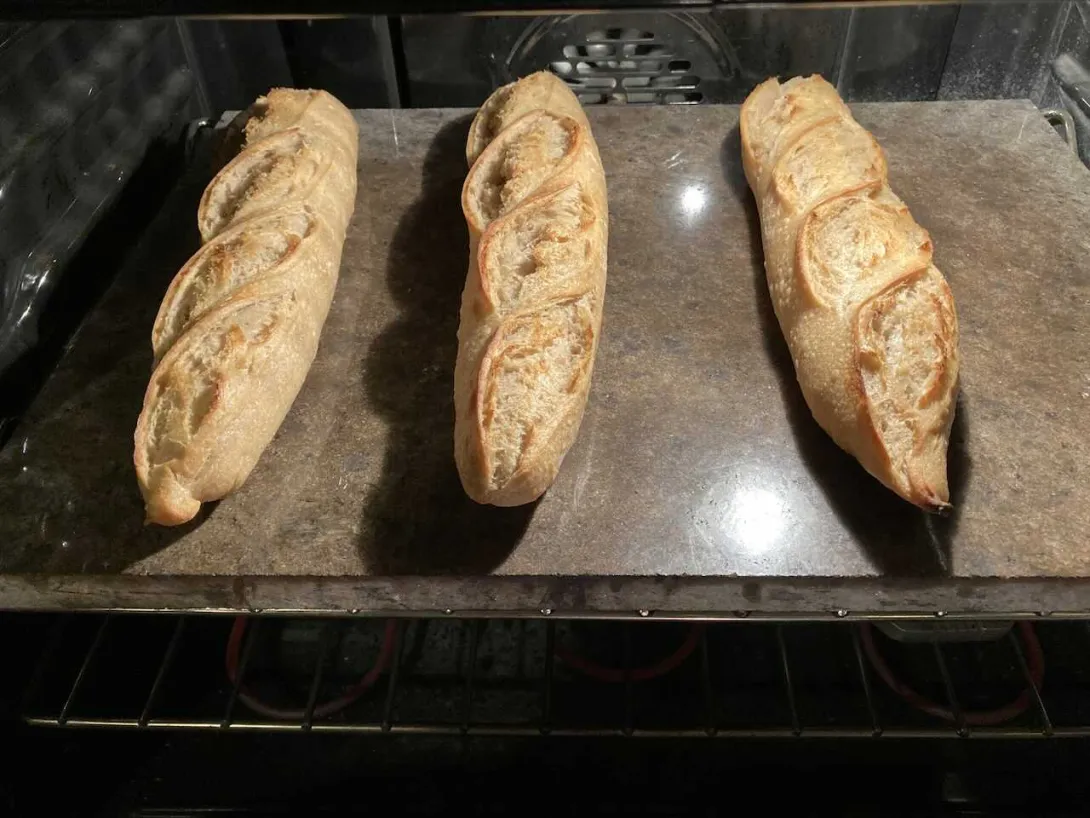
happycat posted about his Yudane bake mere days ago. I'd never heard of Yudane before but he mentioned that it is another Tangzhong type of scald - typically for enriched breads, I would guess. On the back burner for quite some time I still hadn't gotten around to baking with Tangzhong yet. And then happycat posted his Yudane bake. Time to give it a whirl.
With the exception of his posting that 20% of the flour should be from the Yudane, I was flying blind on the formula. So I decided to just construct something that seemed to be about "right", with 20% rye to go along with the remainder as AP flour. 20% pre-fermented flour from my AP levain as well. Whole bunch of "20" going on here!
I've dealt with preferments that were a bit difficult to incorporate, and assuming this would meet that criterion, I added the Yudane to the water first and then broke it up best I could by squishing it between my fingers. That seemed to do the trick and from then on it was smooth sailing. The first 50 French Folds were stiff, but after the 5 minute covered rest, the final 50 were delightful. By the first Letter Fold at minute 50 of the ~2 hr. BF before retard, the dough was completely pliable and extensible. By the second LF my hands could feel the way the dough was developing further, this time with a loft much more present than at the first LF.
Not knowing what to expect, I'm pleased with what emerged from the oven. The bread has a nice crunch to the dark-baked crust. However, the crumb is surprisingly tight considering the significant oven spring - anything to do with the Yudane or just with me? It was also too moist by the time I cut into it, an indication that the Yudane had perhaps corralled moisture that it wasn't ready to let go of by the time the crust had darkened. My remedy for a next time would be to bake at a lower temperature for a longer bake allowing the crumb to dry out more.
I am tasting something "different" from this bread, but unsure of what it is yet. I don't know if the Yudane is taking responsibility. As of this moment it doesn't seem to add such a significant flavor factor, however pleasing the overall taste is.
Far from a negative, for the first time out of the chute, I'm happy with the results. And as usual, I've hopefully learned a thing or two about a thing or two for the next time.
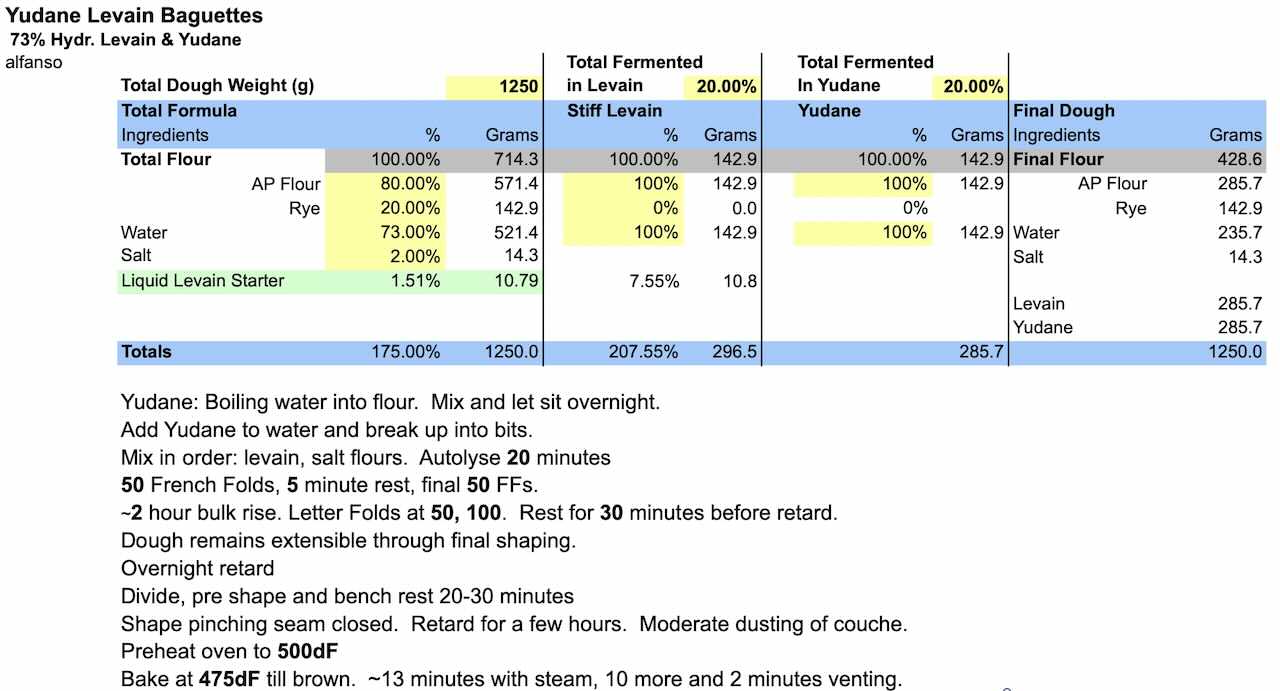
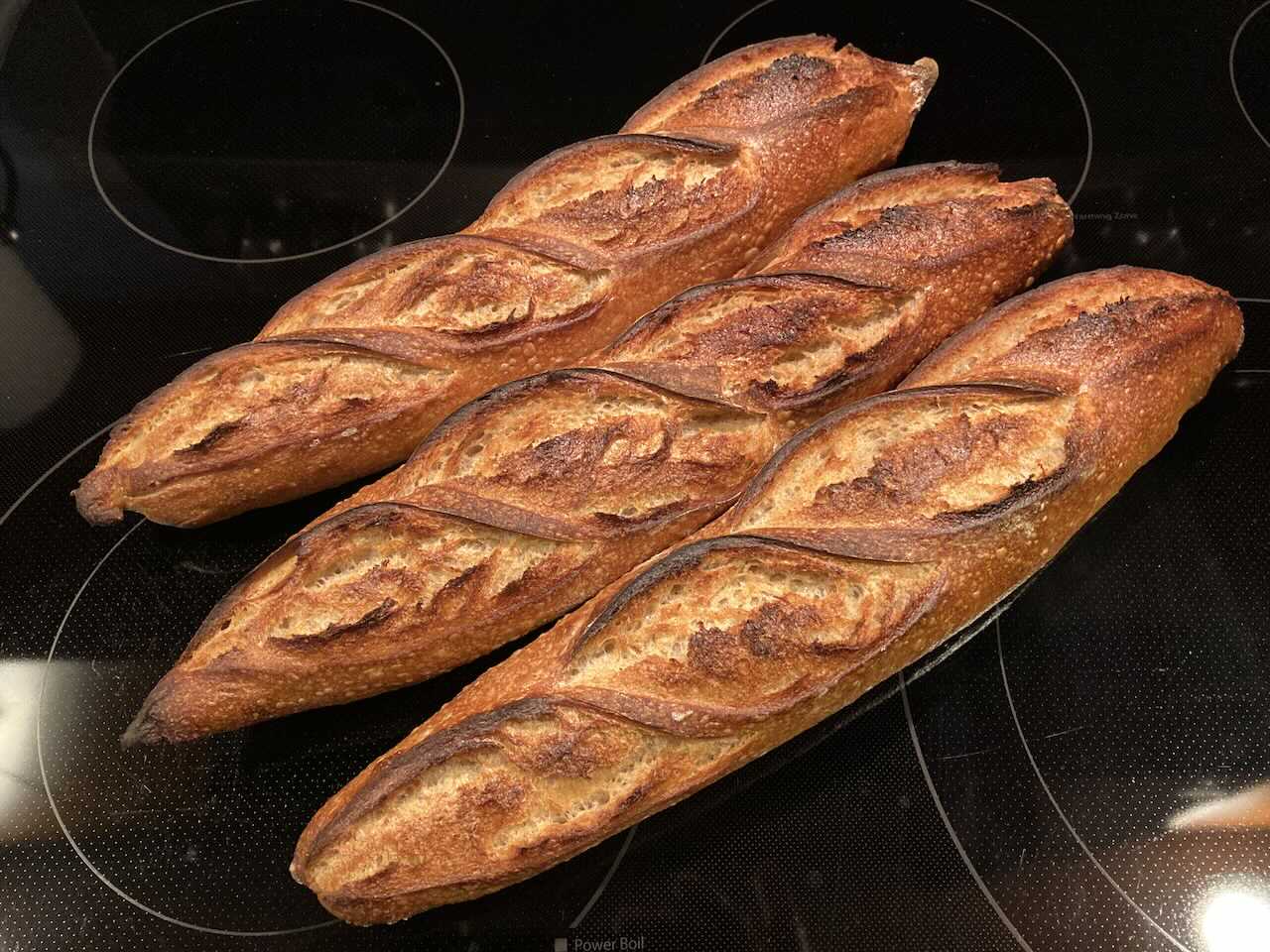
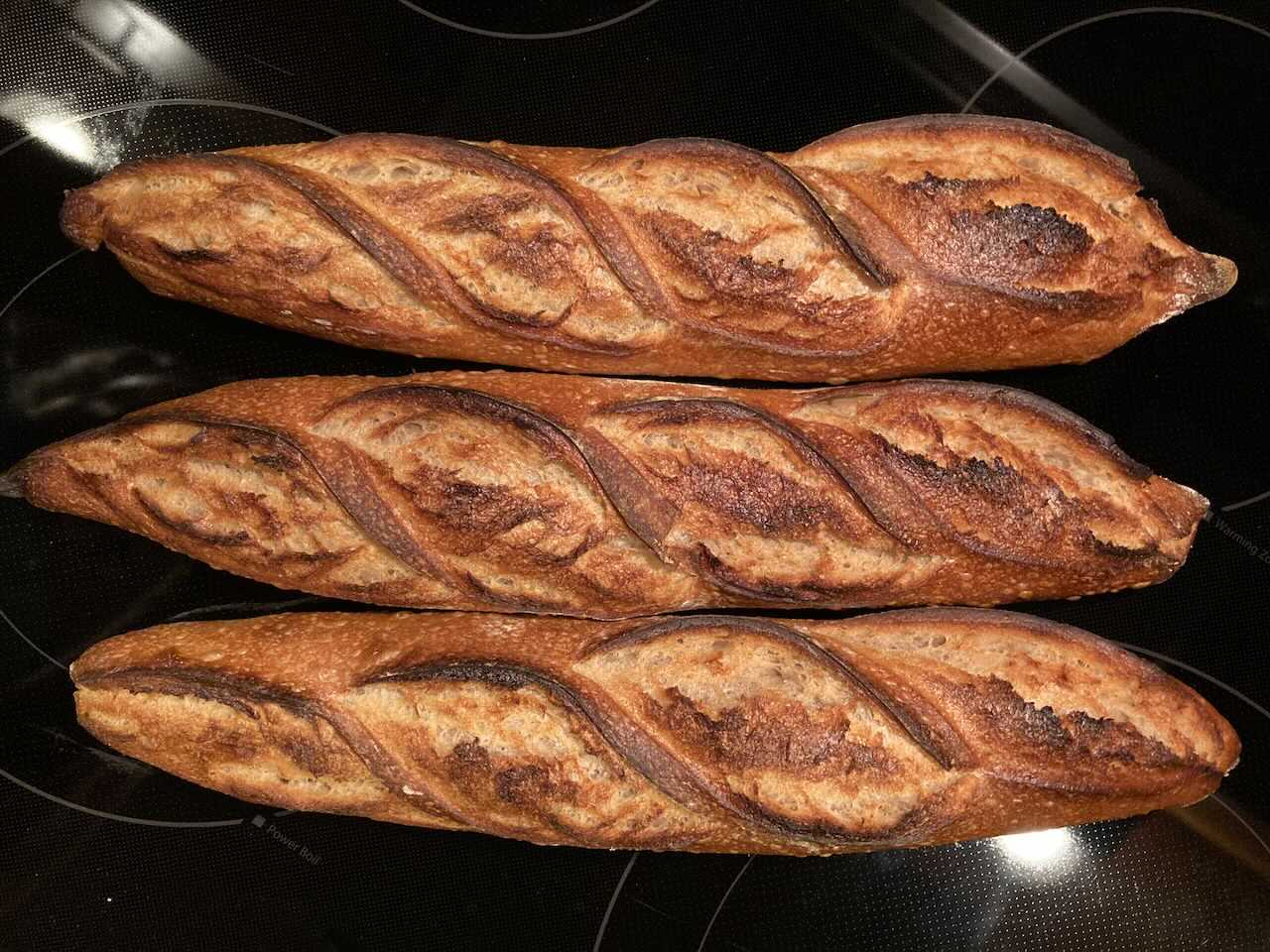
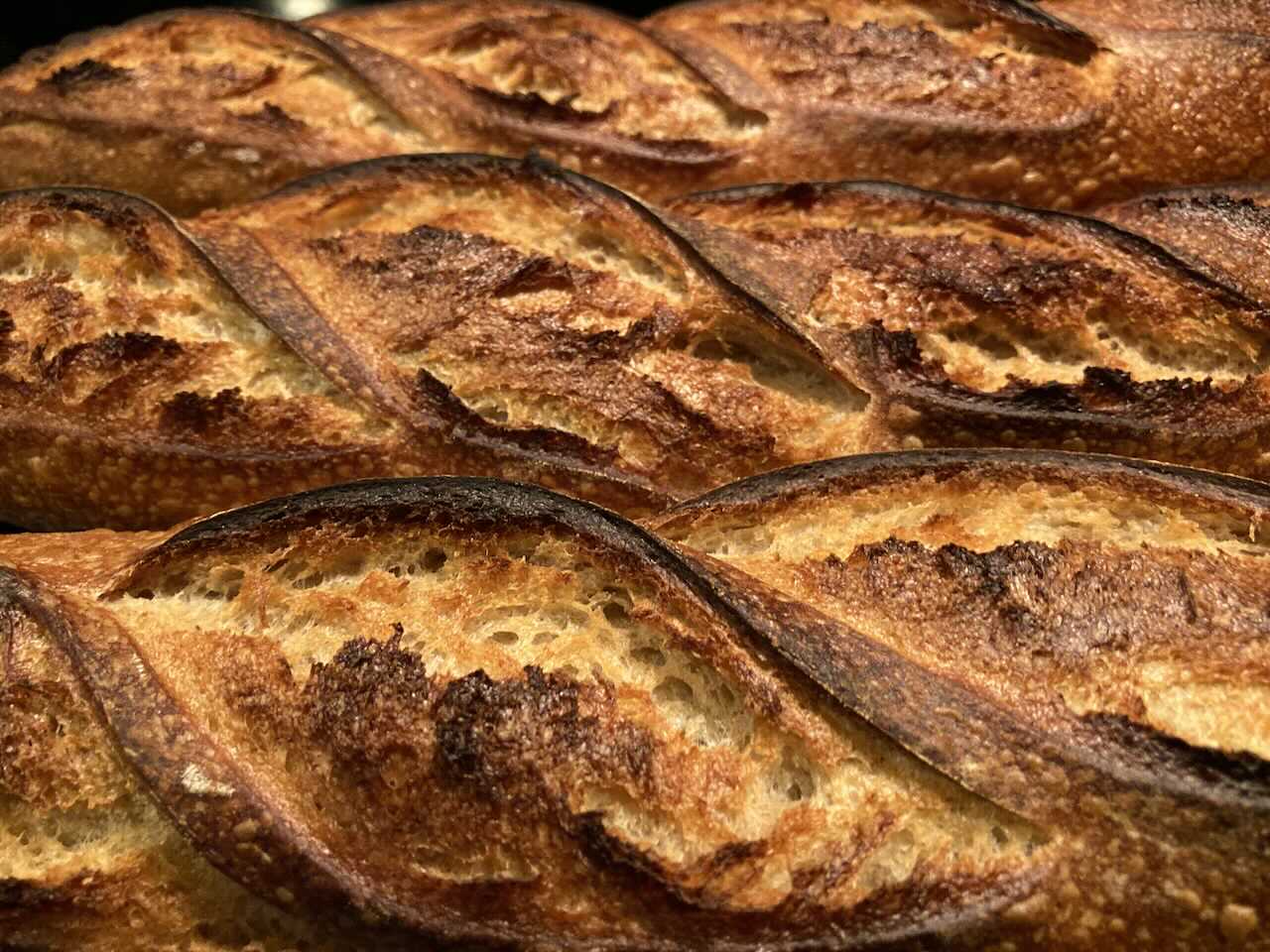
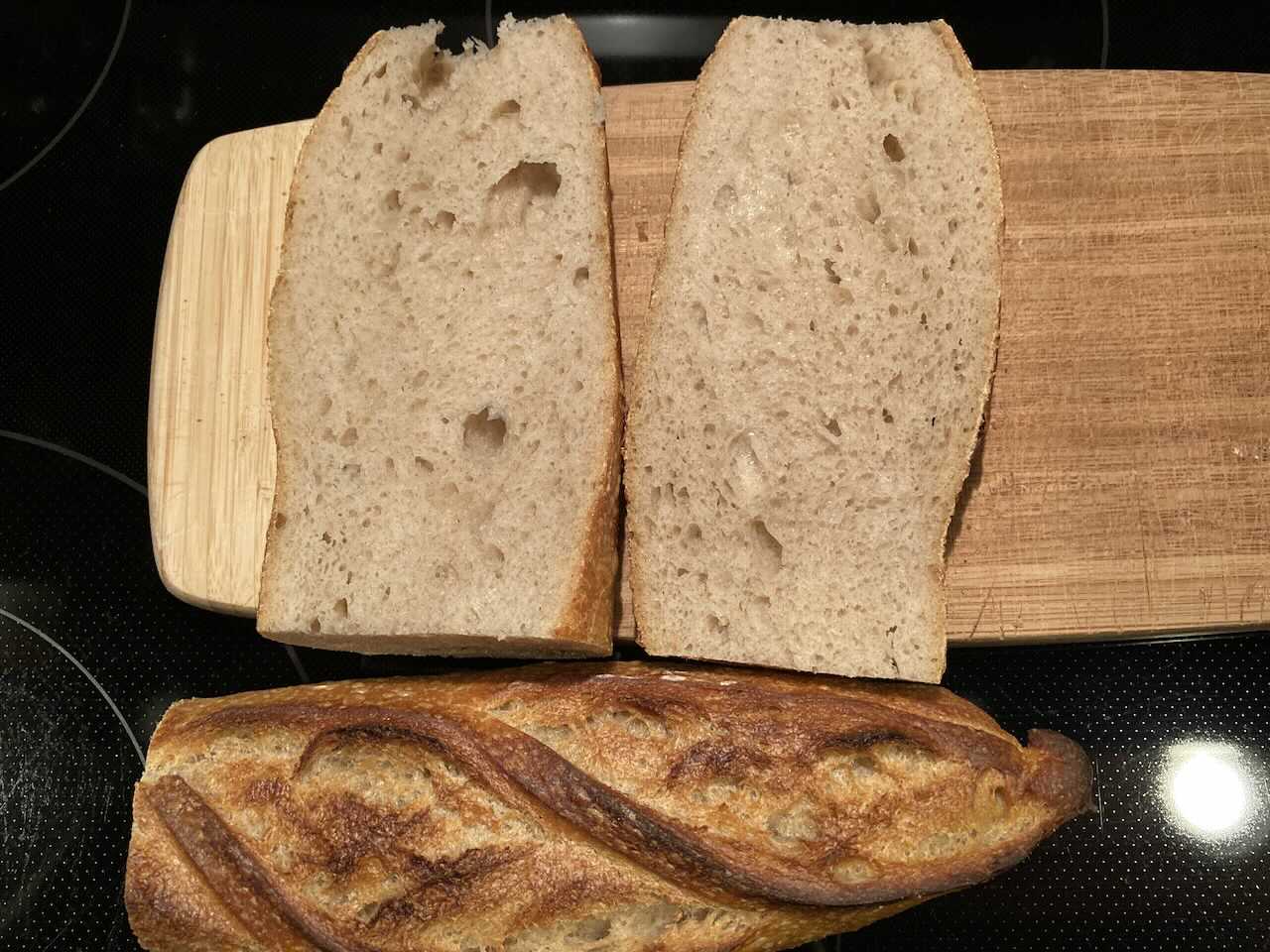
I have an ironclad rule to not peek in the oven door window during the steaming half of the bake, and it was only after that when I released the steam did I have my first peek at the bread.
410g x 3 baguettes/long batards.
- alfanso's Blog
- Log in or register to post comments
Yudane and Tangzhong gelatinizes the starch leading to a crumb that is more moist and will stay fresh longer. I wonder if that gelatinization has lead to the tighter crumb? I believe David (HappyCat) also had such a crumb in his Yudane baguettes. I certainly like my tangzhong for my Hokkaido milk breads that I’ve been working with recently. In fact my first try at a 75% whole wheat Hokkaido sourdough milk bread is almost ready to come out of the oven right now.
Anyhow, excellent looking baguettes up to your usual high standards.
Benny
Hokkaido Milk Bread has been on the drafting board forever. My other sister-in-law used a Tangzhong in her Challah.
What makes the roux special is the moistness that it maintains as well as the likely tighter crumb is what I'm getting so far. Maybe not so good for a bread that should be exhibiting an open crumb, but has other benefits. Hokkaido, here we come. Actually Hokkaido is a destination we haven't made yet, as Kodo and Ondekoza taiko groups are there. Wife still wants to enlist for training sessions with Kodo.
The posting of your latest Milk Bread is getting me revved up!
When we were in Japan almost 2 years ago now, we too didn’t make it to Hokkaido. Going back to Japan is high on my list of places to go back to and also to ensure that we make it to Hokkaido as well. I’ll look forward to your Hokkaido milk bread Alan.
Benny inspired me with his Hokkaido milk bread... so nice to pass on the inspiration. Great job. Yours are way prettier than mine.
I used 20% of free flour (excluding levain) which happened to be entirely my specialty add in flour to the baguette (rest was AP). Adding boiling water to levain or fermented flour would kill the yeast.
I added my yudane after the autolyse along with salt and full levain. I perceived each item to be its own process... autolyse, levain, yudane, to be made separately then blended. I also yudane-d my fresh milled flour and bran to compensate for its qualities.
But all that was my own interpretation, so yours is no less valid.
I started a toasted buckwheat version last night. I messed up the yudane I think because the flour was still hot from toasting when I added boiling water... resulted in flash boiling in the mixing bowl and loss of hydration. I made up for it by remeasuring and topping up water. Also I added the yudane to the autolyse to get more hydration into it as you did here.
One of the things with a yudane or tangzhong is you add more hydration to the dough to compensate for the water locked into the gelatinized portion. Upping hydration might open your crumb.
David
Just the flour and boiling water the night prior. Some of the ciabatta formulas I run call for very stiff biga, ~40-45% hydration so they are really hard to incorporate, which is why I took the earlier rather than later approach to Yudane incorporation.
Unless you've been peeking in without being an active member, then you are very new to TFL (welcome!). Baguettes are my basic "thing" and I've been at it and posting for years around these parts - lots of practice. Benny OTOH is the quintessential quick learner combined with the Thomas Edison coined phrase for his work "10% inspiration, 90% perspiration".
Thanks for the hydration tip. My sweet spot for hydration with a dough destined to be a baguette is usually in the high 60s, and rarely at 73 or higher. I'll take your note to heart. I'm a store-bought flour type of guy and never worked with anything fresh milled, although the pages on TFL are filled with those, like you, who do mill their own flours.
I'll have a look at the rye baker link to learn something new (again and again...)
Thanks, Alan
Your baguette expertise shows. Wow! They look so great.
Yudane firmness probably depends on the flour. With fresh milled wheat it puffed a lot. With buckwheat it was more of a firm paste... but it might be better if I were more careful.
I only recently registered but TFL has helped in the past when I was looking for starter hints. What a great resource.
Also check out this link from rye baker
http://theryebaker.com/on-scalds-and-scalding/
I think it suggests that flavour should be different with scalding because you are killing off yeast and bacteria in scalded flour, while freeing up its sugars to be used in the nonscalded portion of the dough.
Yes I think this quote from the Rye Baker answers the question of the closed crumb from tangzhong/yudane. “ Tangzhong is less a chemical than a physical process. Heating the dough-water slurry pre-cooks the starches in the flour, transforming them into a wet gel. It also hardens the proteins, making them incapable of forming the gluten that gives bread both its structure and chewiness. With increased moisture and diminished gluten-forming capacity, doughs made with tangzhong bake into the tender, close-crumbed, almost cake-like loaves of Hokkaido Milk Bread that line the bakery shelves of the Asian markets that have proliferated throughout Southern California (where I live) and elsewhere.“
Here's a thought... how about making a yudane and levain in one? Take any recipe with a large percentage levain, scald the flour with boiling water and allow to cool. After which add the starter and allow to mature. Proceed as normal.
What might be the cons of doing it this way?
Yeasts can't eat starches. Starches need to be converted into sugar before yeasts can consume it. Flour has natural enzymes for this process allowing for fermentation over time. Scalding the flour, I believe, does the same thing. So it gels the flour for good texture and releases sugars. Explains why long autolyses/saltolyses result in a much improved bread. With this in mind i'm thinking a yudane levain might just be a happier, as well as convenient, levain.
I think you've got something there for sure.
The rye baker describes all kinds of levels of rye sour, fermentations and combinations over multiple days to convert starches to sugars and feed fermentation and create sweetness. I am quite excited to explore that angle... so many things but onky one bake per week :)
I am in the middle of a toasted buckwheat yudane sourdough baguette and it ballooned so much in the overnight cold retard that I was amazed. I wonder if I freed up a bunch of sugar through toasting and yudane-ing? My starter was actually smaller than last time because of a miscalculation.
Kinda like this idea and really love the your idea of a toasted buckwheat yudane. I went through a spell of baking buckwheat bread and often return. Be sure to post your results!
Like you there's only so much i can eat so experimentation is slow.
Talking of rye a Borodinsky bread has a similar technique with a scald and starter build then the starter goes into the scald. All done for balance of flavour. Not called a yudane but practically the same thing. Might be a good way of converting normal recipes to be a yudane recipe.
I'd really like to try that. My understanding is the scald came from europe and they took it to Japan. Japan has all kinds of examples of taking interesting baking ideas and really making them their own. I plan on making a honey castella cake tomorrow. My wife has taught me how heavy western stuff is (bakes, breads, sweets) and how fluffy it is in Japan.
I'll post the buckwheat when it's done. Fingers crossed.
One thing I can think of (i'm sure there's more) where it's vice versa. The technique for sauerkraut I believe came from kimchi.
Personally i'm a fan of nothing too heavy but at the same time not for a really fluffy texture either. I like the western way and wouldn't call it heavy. In comparison to a shop bought white yeasted loaf a homemade sourdough with wholegrains wouldn't be as light and fluffy but I wouldn't call it heavy. It's a meal. Can't beat a good old chocolate cake and wouldn't want it any lighter. Not a fan of overly sweet either. I like to taste the chocolate and shouldn't be overpowered with too much sugar. Wouldn't want a cake that melts in your mouth. But it's all down to taste I suppose and after having seen some videos myself they do have some excellent techniques for getting the textures they want.
There is quite a dependence on vegetable fat, sugar, baking powder, artifical sweeteners and more flour here.
Comparatively, that results in a heavy dessert for instance.
I shifted to making a lot of lighter stuff based on incorporating meringues for leavening, vanilla from beans, less sugar, etc. I was a skeptic believe me for many years. But I am amazed at how flavourful and light stuff can be.
A nice chocolate cake with a good texture, not too sweet and flavourful then be sure to post it. I've never heard of artificial sweeteners in cake but that might be store bought. Can't beat homemade so you know what's in it. I am not biased in anyway but my grandmother made the best marble cake ever.
That's probably true.
Any sponge or genoise based on whites and yolks and vanilla bean would work. Then temper in some real melted chocolate or fold in some high fat cocoa. It's been awhile since I made one but the texture and richness come primarily from the eggs, and some butter.
I don't have a recipe handy. Today I made a honey castella which is the same concept but with honey integrated instead of cocoa or chocolate.
David have you tried using aquafaba for your meringue? I’ve used it and it is quite incredible how well it works. I made a vegan lemon tart and used aquafaba for the decorative meringue. No one knew that it wasn’t egg white meringue. If you’re not familiar aquafaba is the water from the can of beans, I like chickpea water the best and the older the better as more of the proteins will have come out of the chickpeas the longer it is canned.
Benny
wow I gotta check that out. I guess the name comes from bean water. Thanks for the tip! My wife makes hummus a lot so we would have the soaking water from dry beans. I wonder if that would be similar?
I’ve read that the longer the beans have been in the water the more protein is in the water. I have read that home soaked beans may not be up to the task but I have not tested that out.
Regarding starch conversion to sugars and scalding, we do need to ensure that we keep the temperature of the scald below 85ºC because at 85ºC or higher the amylase will denature and won’t be able to convert the starches to sugars. Otherwise, I’m interested in the idea of the levain being made from a scalded flour, that is an interesting idea. One would think that it would ferment quite fast. But because the gluten is damaged we would be relying on the gelatinized starches to hold the fermentation gases in. I wonder how well it would rise? I wonder if it would be similar to a rye levain. I wonder if the rye specialists around TFL have already done this, making a rye scald and then inoculating it, once cooled, with a rye starter to make a scalded levain?
Do differ I would assume it would be easier with a scald. I tried it with a tangzhong and it's very difficult to tell when it's done. It worked well but some instinct and guess work is involved. However even if one over shoots a tangzhong perferment it'll still work. The gelatinized flour in a tangzhong is not such a high percentage. I can understand the need to be careful when a levain is a high percentage due to the integrity of the final dough but with a traditional tangzhong it's only 5% of the total flour. I've even allowed a Hamelman levain, which is high percentage, to really go over and the resulting bread was still fine. I often think we play things really safe when it comes to bread when in reality there's scope to experiment.
For a yudane, or scald, the appearance of the scalded flour is different and I believe you'll be able to notice a difference as it ferments allowing for a more accurate reading. Looking for it to swell and crack as well as going by the aroma. Good point about keeping it under 85°C. When heating up a tangzhong I suppose it gelatinizes before it reaches that temperature with the amylase doing it's job. But pouring it over the flour it's quicker!
So far I think I’ve only used tangzhong and since I’m using milk with the flour it is just the same amount of work to make the tangzhong as it would be to prepare it as a yudane.
It’s so nice to see experimenting and getting out of your comfort zone…..oh wait you did make baguettes again! 😬😎. I have not tried this method yet but have used a Tangzhong many times. Will have to add this to my experimental list. Nice job on this bake. Maybe with the tighter crumb this would have been a good method fir rolls.
Happy baking!
Ian
"I can call you Betty. And Betty, when you call me, you can call me Al".
By no means do I tire of the multitude of formulas I have in my overflowing looseleaf binder. But sometimes a trigger happens. Between happycat's posting and my latent desire to try a Tangzhong, I figured I might as well strike while the irony is hot, else I'll brush it aside for another day/month/year. Next up will be Benny's first posting of Hokkaido Milk Loaf with levain.
I have issues with not often enough getting a more open crumb (see MTloaf - Don, and Benny for how to do it right and to get the envy going), where I don't wish to exacerbate the shortcoming by employing a technique that may enhance a tight crumb. I'll take happycat's suggestion and up the hydration for a return visit, but have the feeling that it will take a lot more water to have a truly open crumb.
Yeah, funny thing about me baking baguettes. Who'da thunk it?
thanks, Alan
Take a look at my buckwheat yudane version. It's a high hydration dough with more open crumb. Still ugly on the outside though :D
Did you use steel to craft these fine beauties?
Thanks for peeking in.
When you ask if I used a steel to craft these, I'm uncertain what you mean. If it is a baking steel, then no, I bake on a granite deck. Other than that I'm unsure what you are referring to. I craft everything by hand except for using a mixer, more now than before. Can you be more specific?
Alan
Yes, I was just inquiring what you baked on. I’ll have to check out granite. Beautiful baguettes! I love cast iron, but I hate being limited to a Dutch oven. Tried steel, but end up with burned bottoms. Frustrating.
I bake on a baking steel and my first bakes also had over baked bottoms. I still bake on my steel but after a modification that cost almost nothing, I no longer have over baked bottom crusts. Using crumpled aluminum foil stuffed into the baking rack that comes with most ovens I have created a shield that insulates the baking steel by placing the steel directly on top of this stuffed rack.
Thank you for the tips, Benito! I don’t have one of those racks, but I should try to replicate something like that. Thank you for the suggestion! My first attempt at the steel was using freshly cracked danko rye with a recipe from Tartine No. 3 (double fermented pumpernickel) and I had nothing under the steel, so maybe my frustration is understood in the labor that went into crafting such delicious dough lol. I should do something more simple as a test bake in the future. My 2nd attempt I used a similar recipe and lowered the hydration for baguettes and used a simple aluminum sheet pan on the bottom rack…..but cant say I was thrilled with the results yet. I wasn’t seeing as much color on top of the baguettes as I was hoping for and an even distribution of golden darkness. For steam in open bakes I’ve been utilizing the Rofco steamers. They really seemed to give me great results last week when I baked oatmeal yudane bread bowls on the cookie sheet, so I really thought that steel would be next level and possible a holly grail. My original idea was to be able to fit 8 baguettes in the oven using the 2 steels and now I am beginning to rethink if that’s even possible with my current apartment oven. At the beginning of the year I was almost ready to pull the trigger on a Rofco oven itself, but I saw enough negatives that I thought I would wait. Now looking at the Chandley Pico Plus.
Maybe next I’ll try foil sandwiched between the oven rack and the sheet pan to reflect direct and excess heat waves. And the next rack up I’ll place the steel 🤞 And if that doesn’t work out, I’ll drop 3-4 grand on a new oven 😆